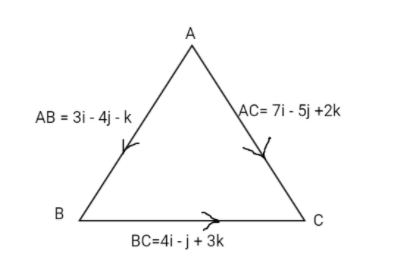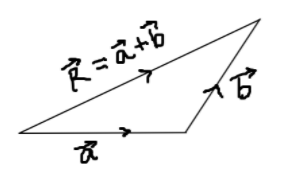Answer
395.1k+ views
Hint: Start by drawing the triangle depicting the two sides with their vectors , using these two vectors find out the third vector . Apply the formula of dot product and find out the angle between any two vectors. Also pay attention to their direction as angle is measured only between two heads or two tails and not between head and tail. Similarly find out other angles as well.
Complete step-by-step answer:

Given , $\overrightarrow {AB} = 3i - 4j - k \& \overrightarrow {BC} = 4i - j + 3k$
We have two sides in the form of vector , Let us try to find out the third side by using triangle law of vector addition as shown below

So , we can obtain side AC by adding the other two sides , by following the above rule for vector addition.
$
\therefore \overrightarrow {AC} = \overrightarrow {AB} + \overrightarrow {BC} \\
\Rightarrow \overrightarrow {AC} = (3i - 4j - k) + (4i - j + 3k) \\
\therefore \overrightarrow {AC} = 7i - 5j + 2k \\
$
Now that we have all the sides of the triangle , we can find the angle between any two sides of the triangles.
We know that angle between two vectors can be found using the formula
$\cos \theta = \dfrac{{\overrightarrow a \cdot \overrightarrow b }}{{\left| {\overrightarrow a } \right| \cdot \left| {\overrightarrow b } \right|}}$
Let us find the angle between side $\overrightarrow {AB} {\text{ & }}\overrightarrow {CB} $ using the above formula.
But $\overrightarrow {CB} = - \overrightarrow {BC} = - 4i + j - 3k$
$
\cos \theta = \dfrac{{\overrightarrow {AB} \cdot \overrightarrow {CB} }}{{\left| {\overrightarrow {AB} } \right|\left| {\overrightarrow {BC} } \right|}} \\
\Rightarrow \cos \theta = \dfrac{{(3i - 4j - k) \cdot ( - 4i + j - 3k)}}{{\left| {3i - 4j - k} \right|\left| {4i - j + 3k} \right|}} \\
\Rightarrow \cos \theta = \dfrac{{ - 12 - 4 + 3}}{{\sqrt {{3^2} + {{( - 4)}^2} + {{( - 1)}^2}} \sqrt {{{( - 4)}^2} + {{(1)}^2} + {{( - 3)}^2}} }} \\
$
Here we used the formula
$
i \cdot i = j \cdot j = k \cdot k = 1 \\
i \cdot j = j \cdot k = k \cdot i = 0 \\
$
Also, for any vector $\overrightarrow P = ai + bj + ck$, then $\left| P \right| = \sqrt {{a^2} + {b^2} + {c^2}} $
$
\Rightarrow \cos \theta = \dfrac{{ - 13}}{{\sqrt {26} \sqrt {26} }} \\
\therefore \cos \theta = \dfrac{{ - 1}}{2} \\
\therefore \theta = {120^ \circ } \\
$
So , the angle between side AB and CB is ${120^ \circ }$.
Similarly, Angle between side AC and BC will be
$
\cos \theta = \dfrac{{\overrightarrow {AC} \cdot \overrightarrow {BC} }}{{\left| {\overrightarrow {AC} } \right|\left| {\overrightarrow {BC} } \right|}} \\
\Rightarrow \cos \theta = \dfrac{{(7i - 5j + 2k) \cdot (4i - j + 3k)}}{{\left| {7i - 5j + 2k} \right|\left| {4i - j + 3k} \right|}} \\
\Rightarrow \cos \theta = \dfrac{{28 + 5 + 6}}{{\sqrt {{7^2} + {{( - 5)}^2} + {{(2)}^2}} \sqrt {{4^2} + {{( - 1)}^2} + {3^2}} }} \\
\Rightarrow \cos \theta = \dfrac{{39}}{{\sqrt {78} \sqrt {26} }} \\
\Rightarrow \cos \theta = \dfrac{{\sqrt 3 }}{2} \\
\therefore \theta = {30^ \circ } \\
$
So , the angle between AC and BC is ${30^ \circ }$.
Now that we know two angles of the triangles ,we can find out the third angle by using the angle sum property of the triangle, which states that the sum of all interior angles is equal to 180.
Therefore, The third angle is equal to ${180^ \circ } - {120^ \circ } - {30^ \circ } = {30^ \circ }$
Therefore , the triangle is a right angled triangle with angles $A = {30^ \circ },B = {120^ \circ },C = {30^ \circ }$
So , option D is the correct answer.
Note: Formation of vector quantity from direction cosines or ratios must be known. Generally , mistakes are committed while doing either the cross or dot product of two vectors , so need to be done carefully. Strict vigilance is required while doing the vector addition and dot products, to the signs as well while multiplying .
Complete step-by-step answer:

Given , $\overrightarrow {AB} = 3i - 4j - k \& \overrightarrow {BC} = 4i - j + 3k$
We have two sides in the form of vector , Let us try to find out the third side by using triangle law of vector addition as shown below

So , we can obtain side AC by adding the other two sides , by following the above rule for vector addition.
$
\therefore \overrightarrow {AC} = \overrightarrow {AB} + \overrightarrow {BC} \\
\Rightarrow \overrightarrow {AC} = (3i - 4j - k) + (4i - j + 3k) \\
\therefore \overrightarrow {AC} = 7i - 5j + 2k \\
$
Now that we have all the sides of the triangle , we can find the angle between any two sides of the triangles.
We know that angle between two vectors can be found using the formula
$\cos \theta = \dfrac{{\overrightarrow a \cdot \overrightarrow b }}{{\left| {\overrightarrow a } \right| \cdot \left| {\overrightarrow b } \right|}}$
Let us find the angle between side $\overrightarrow {AB} {\text{ & }}\overrightarrow {CB} $ using the above formula.
But $\overrightarrow {CB} = - \overrightarrow {BC} = - 4i + j - 3k$
$
\cos \theta = \dfrac{{\overrightarrow {AB} \cdot \overrightarrow {CB} }}{{\left| {\overrightarrow {AB} } \right|\left| {\overrightarrow {BC} } \right|}} \\
\Rightarrow \cos \theta = \dfrac{{(3i - 4j - k) \cdot ( - 4i + j - 3k)}}{{\left| {3i - 4j - k} \right|\left| {4i - j + 3k} \right|}} \\
\Rightarrow \cos \theta = \dfrac{{ - 12 - 4 + 3}}{{\sqrt {{3^2} + {{( - 4)}^2} + {{( - 1)}^2}} \sqrt {{{( - 4)}^2} + {{(1)}^2} + {{( - 3)}^2}} }} \\
$
Here we used the formula
$
i \cdot i = j \cdot j = k \cdot k = 1 \\
i \cdot j = j \cdot k = k \cdot i = 0 \\
$
Also, for any vector $\overrightarrow P = ai + bj + ck$, then $\left| P \right| = \sqrt {{a^2} + {b^2} + {c^2}} $
$
\Rightarrow \cos \theta = \dfrac{{ - 13}}{{\sqrt {26} \sqrt {26} }} \\
\therefore \cos \theta = \dfrac{{ - 1}}{2} \\
\therefore \theta = {120^ \circ } \\
$
So , the angle between side AB and CB is ${120^ \circ }$.
Similarly, Angle between side AC and BC will be
$
\cos \theta = \dfrac{{\overrightarrow {AC} \cdot \overrightarrow {BC} }}{{\left| {\overrightarrow {AC} } \right|\left| {\overrightarrow {BC} } \right|}} \\
\Rightarrow \cos \theta = \dfrac{{(7i - 5j + 2k) \cdot (4i - j + 3k)}}{{\left| {7i - 5j + 2k} \right|\left| {4i - j + 3k} \right|}} \\
\Rightarrow \cos \theta = \dfrac{{28 + 5 + 6}}{{\sqrt {{7^2} + {{( - 5)}^2} + {{(2)}^2}} \sqrt {{4^2} + {{( - 1)}^2} + {3^2}} }} \\
\Rightarrow \cos \theta = \dfrac{{39}}{{\sqrt {78} \sqrt {26} }} \\
\Rightarrow \cos \theta = \dfrac{{\sqrt 3 }}{2} \\
\therefore \theta = {30^ \circ } \\
$
So , the angle between AC and BC is ${30^ \circ }$.
Now that we know two angles of the triangles ,we can find out the third angle by using the angle sum property of the triangle, which states that the sum of all interior angles is equal to 180.
Therefore, The third angle is equal to ${180^ \circ } - {120^ \circ } - {30^ \circ } = {30^ \circ }$
Therefore , the triangle is a right angled triangle with angles $A = {30^ \circ },B = {120^ \circ },C = {30^ \circ }$
So , option D is the correct answer.
Note: Formation of vector quantity from direction cosines or ratios must be known. Generally , mistakes are committed while doing either the cross or dot product of two vectors , so need to be done carefully. Strict vigilance is required while doing the vector addition and dot products, to the signs as well while multiplying .
Recently Updated Pages
Basicity of sulphurous acid and sulphuric acid are

Assertion The resistivity of a semiconductor increases class 13 physics CBSE

The Equation xxx + 2 is Satisfied when x is Equal to Class 10 Maths

What is the stopping potential when the metal with class 12 physics JEE_Main

The momentum of a photon is 2 times 10 16gm cmsec Its class 12 physics JEE_Main

Using the following information to help you answer class 12 chemistry CBSE

Trending doubts
Difference Between Plant Cell and Animal Cell

Difference between Prokaryotic cell and Eukaryotic class 11 biology CBSE

What is BLO What is the full form of BLO class 8 social science CBSE

Change the following sentences into negative and interrogative class 10 english CBSE

Fill the blanks with the suitable prepositions 1 The class 9 english CBSE

What organs are located on the left side of your body class 11 biology CBSE

The cell wall of prokaryotes are made up of a Cellulose class 9 biology CBSE

Select the word that is correctly spelled a Twelveth class 10 english CBSE

a Tabulate the differences in the characteristics of class 12 chemistry CBSE



